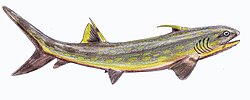Sphenacanthus
| Sphenacanthus | |
|---|---|

| |
| Scientific classification | |
| Kingdom: | |
| Phylum: | |
| Class: | |
| Subclass: | |
| Order: | |
| Family: | |
| Genus: | Sphenacanthus Agassiz, 1837[1]
|
| Type species | |
| Sphenacanthus serrulatus Agazzis, 1837
| |
| species | |
| |
Sphenacanthus is an extinct genus of a chondrichtyan xenacanthiform that belongs to the Sphenacanthidae family and lived from the Late Devonian, through Carboniferous until the Late Permian period in Scotland,[2] Spain,[3] Russia[4] and Brazil.[5] It lived 359 million years ago, and probably it was one of the first member of the elasmobranchians, the lineage that leads to the modern sharks. Sphenacanthus probably hunts small fishes and, unlike their modern-day relatives, its inhabited fresh water lagoons. Sphenacanthus had seven fins, two in the upper part and five in the underside, and it have a heterodont dentition and mandibles relatively long and deeper.[2] Sphenacanthus serrulatus is still only known from incomplete neurocranial remains and associated dermal material. These suggest that it was a relatively large shark,probably well over one meter in length when fully grown. Its body form was probably similar to that of other phalacanthous sharks.[6]
Paleobiology
Sphenacanthus was discovered in Carboniferous terrains of Scotland (Visén Oil Shale Groups), in the United Kingdom, in ancient fresh water systems, a habitat that also is known in the Paraná Basin in Brazil (Rio do Rasto Formation). Another findings, like those of the Puertollano Bason in Spain suggests that also it lived in zones of marine influence, in brackish waters.[5] It shared its environment with other primitive sharks, including to Xenacanthus of one meter in length and the similar species, Tristychius arcuatus.[2] It is possible that Sphenacanthus may have preyed on its smaller relatives.
References
- ^ L. Agassiz. 1837. Recherches Sur Les Poissons Fossiles. Tome III (livr. 8-9). Imprimérie de Petitpierre, Neuchatel viii-72
- ^ a b c Dick, John R. F. (1998). "Sphenacanthus, a Palaeozoic freshwater shark". Zoological Journal of the Linnean Society. 122 (1–2): 9–25. doi:10.1111/j.1096-3642.1998.tb02523.x.
- ^ Soler-Gijón, R. 1997. Euselachian sharks from the Late Carboniferous of the Puertollano Basin, Spain: bioestratigraphicand palaeoenvironmental implications. Modern Geology, 21:137-169.
- ^ A. Ivanov. 1999. Late Devonian - Early Permian chondrichthyans of the Russian Arctic. Acta Palaeontologica Polonica 49(3):267-285
- ^ a b V. E. Pauliv, E. V. Dias, and F. A. Sedor. 2012. A new species of sphenacanthid (Chondrichthyes, Elasmobranchii) from the Rio do Rasto Formation (Paraná basin), southern Brazil. Revista Brasileira de Paleontologia 15:243-250
- ^ JOHN R. F. DICK, Sphenacanthus, a Palaeozoic freshwater shark, Zoological Journal of the Linnean Society, Volume 122, Issue 1-2, January 1998, Pages 9–25, https://doi.org/10.1111/j.1096-3642.1998.tb02523.x
Further reading
- Chahud, A.; Fairchild, T.R. & Petri, S. 2010. Chondrichthyans from the base of the Irati Formation (Early Permian, Paraná Basin), São Paulo, Brazil. Gondwana Research, 18:528-537.doi:10.1016/j.gr.2010.01.006
- Silva-Santos, R. 1946. Duas novas formas de Elasmobrânquios do Paleozóico do Meio Norte, Brasil. Anais da Academia Brasileira de Ciências, 18:281-287.
- Silva-Santos, R. 1947. Um Ctenacanthus do Gondwana brasileiro. Anais da Academia Brasileira de Ciências, 19:247-253.
